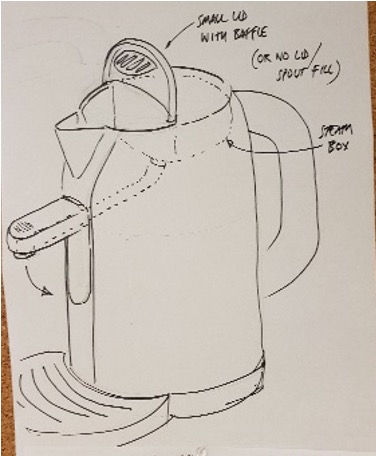SJD Designs.
Design Engineer | NPD Specialist | CAD Prototyping | Sustainability Advocate
HotCup Duality – Combined Kettle & One-Cup Dispenser
Eliminates habitual over-filling, saving up to £12 per home and tackling a national £68 million energy-waste problem.
Goal:
Reduce the frequency of over boiling kettles in the UK by delivering a dual-function kettle and hot cup appliance, combining speed, convenience, energy efficiency and safety.
Timeline:
Jan – Sep 2019
Team:
3 Strix engineers + Kinneir Dufort (Contracted Consultancy) designers.
Placement Role:
Engineering Intern, Strix.
Patent:
PCT/GB2020/000123 – named inventor
Overview

Problem Statement & Market Context
The UK faces a significant energy waste issue due to kettle usage patterns.
75% of British households overfill their kettles, leading to environmental and economic impacts.
95% of households use kettles daily
40% boiling water five or more times a day
British households waste 2.6 million kWh of electricity daily from overfilling resulting in;
Costing £68 million annually to the economy.
70 million litres of water wasted daily.
Each household could potentially save £11-12 per year by boiling water more efficiently.
This inefficiency contributes to a national energy crisis.
My Role and Resposibilities
Engineering Intern at Strix Ltd working predominintely on;
Concept generation & CAD
Prototype build and lab testing
Mechanism, sealing and force optimisation
Patent data pack authoring and CAD DFM for OEM hand-off
Project Scope and Responsibilities
Combine kettle and dispenser in one appliance.
HotCup "mode": Meet hot-cup delivery < 45 s, 150-300 mL ±25 mL at ≥ 90 °C.
Kettle "mode": Preserve 1.7 L kettle capacity & 240 s boil time.
FOB target $18-22; secure IP for dual-mode mechanism.
Technical Process
Phase 1: Concept Research and Ideation
Conducted market and consumer research, leading to ideation sessions focused on speed, convenience, and energy efficiency.
Explored engineering feasibility and initial changeover concepts for combining kettle and hot cup functionalities in one device.
Collaborated with a design consultancy to refine the product concept based on feedback.
Phase 2: Prototype Development and Validation
Created and iteratively improved mock-ups, testing and modifying them to enhance system performance.
Evaluated multiple actuation methods (e.g., push-rod mechanisms, flap linkages) and user-interface designs.
Ran performance tests (e.g., dispense times, temperatures, noise) to benchmark against targets.
Incorporated feedback from consumer research and technical testing to refine functional prototypes.
Phase 3: Technical Optimisation and DFM
Addressed manufacturing challenges, cost, and weight issues by revisiting design specifics.
Conducted detailed optimisation of joint mechanisms and seals to improve durability and safety.
Prepared the prototype for manufacturer review, ensuring it met industrial and performance requirements.



